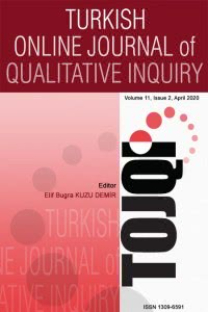Primary School Teacher Candidates' Experiences Regarding Problem-Based Stem Applications
Sınıf Öğretmeni Adaylarının Probleme Dayalı STEM Uygulamalarına Yönelik Deneyimleri
___
Adams, A. E., Miller, B. G., Saul, M., & Pegg, J. (2014). Supporting elementary teacher candidates to teach STEM through place-based teaching and learning experiences. Electronic Journal of Science Education, 18(5), 1-22.Avery, Z. K., & Reeve, E. M. (2013). Developing effective STEM professional development programs. Journal of Teacher Education, 25(11), 55–67. Retrieved from https://scholar.lib.vt.edu/ejournals/JTE/
Anagün, S.Ş., Atalay, N., Kılıç, Z. & Yaşar, S. (2016). Öğretmen adaylarına yönelik 21. Yüzyıl becerileri yeterlilik algıları ölçeğinin geliştirilmesi: Geçerlik ve güvenirlik çalışması. Pamukkale Üniversitesi Eğitim Fakültesi Dergisi, 40, 160-175.
Banilower, E. R., Smith, P. S., Weiss, I. R., Malzahn, K. M., Campbell, K. M., & Weis, A. M. (2013). Report of the 2012 national survey of science and mathematics education. Chapel Hill, NC: Horizon Research, Inc.
Baş, T. ve Akturan, U. (2017). Sosyal bilimlerde bilgisayar destekli nitel araştırma yöntemleri. Ankara: Seçkin Yayıncılık.
Brophy, S., Klein, S., Portsmore, M., & Rogers, C. (2008). Advancing engineering education in P-12 classrooms. Journal of Engineering Education, 97(3), 369–387. doi:10.1002/jee.2008.97.issue-3
Cohen, D. K., & Hill, H. C. (1998). Instructional policy and classroom performance: The mathematics reform in California (RR-39). Philadelphia: Consortium for Policy Research in Education.
English, L. D., & King, D. T. (2015). STEM learning through engineering design: Fourth grade students’ investigations in aerospace. International Journal of STEM Education, 2(1), 14. https://doi.org/10.1186/s40594-015-0027-7
Estapa, A. T., & Tank, K. M. (2017). Supporting integrated STEM in the elementary classroom: a professional development approach centered on an engineering design challenge. International Journal of STEM education, 4(1), 6.
Fennema, E., Carpenter, T. P., Franke, M. L., Levi, L., Jacobs, V. R., & Empson, S. B. (1996). A longitudinal study of learning to use children’s thinking in mathematics instruction. Journal for Research in Mathematics Education, 27(4), 403–434.
Guskey, T. R., & Yoon, K. S. (2009). What works in professional development?. Phi Delta Kappan, 90(7), 495-500.
Guzey, S. S., Harwell, M., Moreno, M., Peralta, Y., & Moore, T. (2017). The impact of designbased STEM integration curricula on student achievement in engineering, science, and mathematics. Journal of Science Education & Technology, 26, 207–222. https://doi.org/10.1007/s10956-016-9673-x
Jeffrey, T. D., McCollough, C. A., & Moore, K. (2015). Growing STEM roots: Preparing preservice teachers. Academic Exchange Quarterly, 19(3), Retrieved from http://rapidintellect.com/AEQweb/5617j5.pdf
Karahan, E. (2017). STEM eğitimi. Ö. Taşkın (Ed.). Fen eğitiminde güncel konular. (pp. 318- 333). Ankara: Pegem Akademi.
MacFarlane, B. (2016). Infrastructure of comprehensive STEM programming for advanced learners. In B. MacFarlane (Ed.), STEM education for high ability learners designing and ımplementing programming (pp. 139–160). Waco, TX: Prufrock Press.
MEB. [Milli Eğitim Bakanlığı]. (2018). Fen bilimleri öğretim programı (İlkokul ve ortaokul 3, 4, 5, 6, 7 ve 8). Ankara: Milli Eğitim Bakanlığı.
Moore, T. J., Glancy, A. W., Tank, K. M., Kersten, J. A., Smith, K. A., & Stohlmann, M. S. (2014). A framework for quality K-12 engineering education: Research and development. Journal of Pre-College Engineering Education Research (J-PEER), 4(1), 2.
National Science Board (2010). Preparing the Next Generation of STEM Innovators: Idenfitying and Developing our Nation’s Human Capital. Retrieved from http://www.nsf.gov/nsb/publications/2010/nsb1033.pdf
National Staff Development Council. (2001). National Staff Development Council’s standards for staff development (Rev. ed.). Oxford, OH: Author. Available from http://www.nsdc.org/ library/standards2001.html
Orpwood, G., Schmidt, B., & Jun, H. (2012). Competing in the 21st Century Skills Race. Ottawa: Canadian Council of Chief Executives
Patton, Q. M. (2014). Nitel araştırma ve değerlendirme yöntemleri. M. Bütün ve Demir B. S. (Çev.). Ankara: Pegem Akademi. (Özgün çalışma 2002).
Stohlmann, M., Moore, T. J., & Roehrig, G. H. (2012). Considerations for teaching integrated STEM education. Journal of Pre-College Engineering Education Research (JPEER), 2(1), 4.
Yıldırım, A. ve Şimşek, H. (2011). Sosyal bilimlerde araştırma yöntemleri. Ankara: Seçkin Yayınları.
Zeidler, D. L., Herman, B. C., Clough, M. P., Olson, J. K., Kahn, S., & Newton, M. (2016). Humanitas emptor: Reconsidering recent trends and policy in science teacher education. Journal of Science Teacher Education, 27(5), 465–476.
- ISSN: 1309-6591
- Yayın Aralığı: 4
- Başlangıç: 2010
- Yayıncı: Prof.Dr. Abdullah Kuzu
Sosyal-eylem-odaklı Öğrenmede Eğitimsel Projelerin Uygulaması
Analysis of Unit Evaluation Questions in the $4^{th}$ and $5^{th}$ Grade Social Studies Books
Tekin ÇELİKKAYA, Mutlu KÜRÜMLÜOĞLU
The Implementation of Educational Projects in Social-action-based Learning
Primary School Teacher Candidates' Experiences Regarding Problem-Based Stem Applications
Saime Şengül ANAGÜN, Engin KARAHAN, A. Zeynep KILIÇ
4. ve 5. Sınıf Sosyal Bilgiler Kitaplarında Yer Alan Ünite Değerlendirme Sorularının Analizi
Tekin ÇELİKKAYA, Mutlu KÜRÜMLÜOĞLU
Sınıf Öğretmeni Adaylarının Probleme Dayalı STEM Uygulamalarına Yönelik Deneyimleri
